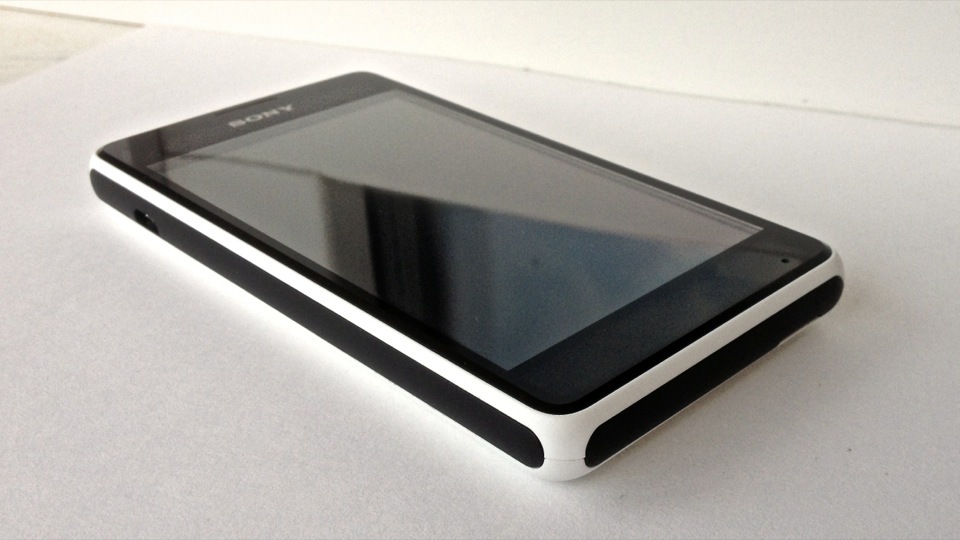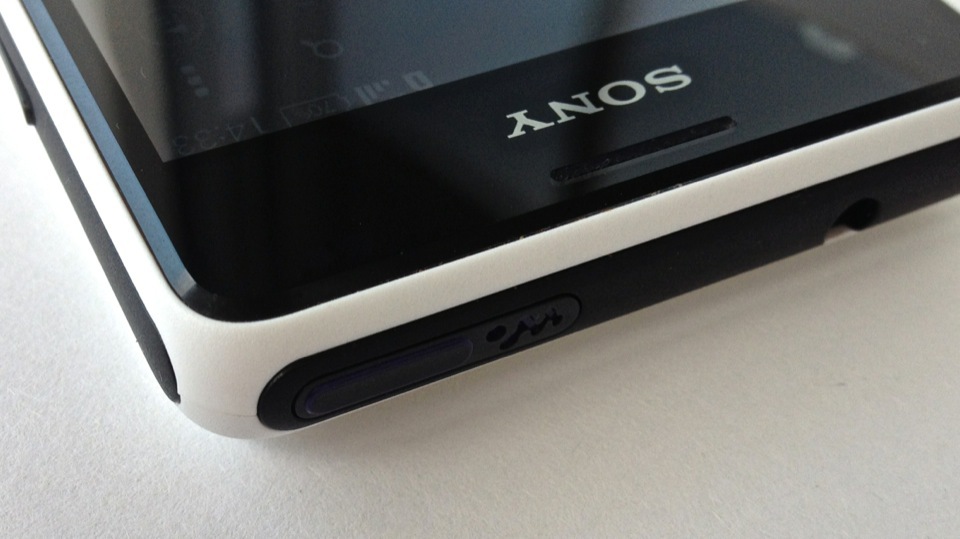Review Xperia E1
Browsers, as a rule, pay maximum attention to the flagships, but practically do not notice the budget models. We decided to restore justice and offer you an overview of the most affordable model from the current line of Sony Mobile - Xperia E1.

Appearance and Ergonomics
Externally, the E1 does not at all look like the older models of this year - no strict lines, metal and chrome, but the state employee looks no less stylish. A thick white case with black accents (black and purple versions are available) and rounded corners fits well in the hand, although the power button could be taller (at least my thumb “by default” doesn’t fall on it). The glass covering the screen protrudes slightly from the case, showing fashionable beveled angles, but the camera lens, on the contrary, is recessed into the case, which reduces the likelihood of damage. The plastic is rather rough, with a large relief, but it doesn’t create the impression of “cheap”; there are no complaints about the build quality either - everything is strong, reliable, the buttons have a clear short stroke, nothing hangs and does not play.


To remove the back cover you need to have a certain dexterity - it holds very well and reliably and, at first glance, you can’t even guess that the phone is disassembled in this way. Under the lid we see a pretty familiar picture for public sector employees - a removable battery, under which there are slots for "classic" SIM cards, and a little higher - a microSD slot, it can be changed without removing the battery, which can not be said about SIM cards, however, after their installation in any case would have to reboot the device.
On the left, like other models developed as part of the OmniBalance concept, there is a round power button and a volume rocker, at the top there is a headphone jack and a Walkman button, familiar to old Sony fans from a number of models. When the device is in standby mode, a long press on this button displays the player control interface on the lock screen, a short press starts the track or pauses it, and double-clicking switches it to the next track. If you hold down the button and shake the phone, Shuffle mode will be activated. Very convenient functions for those who prefer to switch music directly in their pocket and do not use a headset with a control panel.


On the right there is nothing but a Micro-USB connector, and at the bottom there is a special recess, with which you can pick up the lid with your fingernail, and you can thread the cord there. The back panel is decorated with a brilliant Sony logo and an impressive size grille covering the main speaker (in fact, the speaker itself is three times smaller and is located in its left part).
Under the screen there is a miniature microphone hole and an LED with a diffuser, which is responsible for notifications and dynamic illumination when viewing images, smoothly color me in accordance with the general gamma of the image or album cover (you can remember a similar function by Xperia SP).
Display
Here we have a rather modest 4-inch TFT-display with a resolution of 480x800 and an image density of 233 ppi. With such a modest size, in principle, this is quite acceptable and it is quite difficult to notice the pixelation with the naked eye. The image is moderately saturated, without “acidic” notes and quite contrasting, although when tilted, the contrast decreases slightly and the image fades, but these are typical TFT problems. However, this does not create significant problems, at least when reading or surfing the web, at a right angle you have to hold the phone only when viewing insufficiently contrasting images or dark scenes in films.


Like other models of this year, the screen no longer has a factory film, but a protective coating appeared, thanks to which the finger glides perfectly on the display and leaves virtually no traces, and if any appear, they are very easy to remove without the use of special tools. The touchpad is quite clear, supports 10 simultaneous touches, with excellent sensitivity and without noticeable glitches.
Camera
Of course, you cannot demand much from the camera of such an inexpensive smartphone, but it copes with its functions. Highly artistic photographs are, of course, difficult to obtain, but for everyday needs such as shooting documents or other utilitarian purposes, it is more than enough. Three-megapixel allows you to take pictures with a maximum resolution of 2048x1536 and shoot quite decent HD-video. In addition to the automatic mode, there is also manual, which allows you to adjust the shutter speed, white balance, sensitivity and stabilization mode, as well as use HDR. There are some simple graphical effects such as sepia and pencil sketch imitation, and the panoramic mode. Unfortunately, you cannot connect new functions. With sufficient lighting, the camera shoots pretty well, but in the dark it produces a lot of noise,






Iron and performance
A big plus of E1 compared to the “classmates” is the use of the Qualcomm Snapdragon 200 chipset, while most modern budget smartphones use MediaTek chips. E1 does not set records, but for the everyday use of his resources it is even enough, and it is not only about mail, social networks and reading books, but also about watching videos in an acceptable quality, and not the most voracious three-dimensional games work here without visible problems . The interface works quite smoothly, unlocking and launching applications takes no more than a second, some jerks are noticeable only if various graphic effects are included such as smooth animation or “live” wallpapers, but this can be attributed to not the largest amount of RAM - 512 MB. The amount of internal memory is 4 GB,
Test Results:

Sound
The main feature of the E1 is a powerful speaker and emphasis on improving sound quality. The phone copes with the task of playing music with a bang and without any problems replaces the audio player. If the sound quality of most inexpensive smartphones can only be called satisfactory, then the E1 has everything in order and it sounds at a very decent level. When listening to the headphones there is no hint of distortion, lack of bass or “sand” in the higher frequencies, which, as a rule, cheap devices suffer from. All the same audio technologies are supported as in "adult" models - this is a comprehensive ClearAudio + "enhancer", an equalizer, a stereo expander, xLoud to increase the volume of an external speaker and a dynamic normalizer that equalizes tracks in volume. As for the volume, there are plenty of it in the headphones,
Autonomy
Someone can say that 1700 mAh, by today's standards, is a bit, but very modest requests from the screen and the iron filling allow the E1 to work quietly on one charge for two days, and this is when used intensively while listening to a lot of music, navigation , calls and the constant use of social networks. The mass distribution of external batteries, in principle, negates the value of removable batteries, but the ability to independently replace a faulty battery is a definite plus.
Soft and Communication
By default, Android 4.3 with Sony’s standard shell is installed on the E1, and the first time you connect to the computer, you can upgrade to 4.4 (“over the air”, unfortunately, is not installed). The minimum set of pre-installed software is File Commander, Evernote, TrackID + a standard “Google” kit and a small set of widgets, the same as all Sony smartphones over the past few years.
The dual SIM mode allows you to use one simultaneously for calls and the other for Internet access, or separately select the communication option before each call. Cards can be given names, and in case one of the cards is out of network coverage, a call can be forwarded to another. There are no complaints about the quality of communication, the signal is stable, the sound quality during the conversation is excellent, the Internet and navigation work without problems.


Summary
A very decent budget device that justifies its price by 150% and is not inferior to competitors, and in some places surpasses them. Unpretentious, reliable and durable, with a loud sound, good autonomy and performance, sufficient for most everyday tasks and many entertainments. Suitable for those who do not require exorbitant performance from the smartphone and prefer the music of photography, or can be successfully used as a second device.
Specifications
Processor : 2-core Qualcomm Snapdragon 200, 1.2 GHz
Memory : 512 MB RAM, 4 GB internal, SD card slot (up to 32 GB)
Video accelerator : Adreno 302
Display : 4 inches, TFT, 480x800
Camera : 3 MP
Battery : 1700 mAh
OS : Android 4.3
Protection : no
Dimensions : 62.4 x 118 x 12 mm
Appearance and Ergonomics
Externally, the E1 does not at all look like the older models of this year - no strict lines, metal and chrome, but the state employee looks no less stylish. A thick white case with black accents (black and purple versions are available) and rounded corners fits well in the hand, although the power button could be taller (at least my thumb “by default” doesn’t fall on it). The glass covering the screen protrudes slightly from the case, showing fashionable beveled angles, but the camera lens, on the contrary, is recessed into the case, which reduces the likelihood of damage. The plastic is rather rough, with a large relief, but it doesn’t create the impression of “cheap”; there are no complaints about the build quality either - everything is strong, reliable, the buttons have a clear short stroke, nothing hangs and does not play.
To remove the back cover you need to have a certain dexterity - it holds very well and reliably and, at first glance, you can’t even guess that the phone is disassembled in this way. Under the lid we see a pretty familiar picture for public sector employees - a removable battery, under which there are slots for "classic" SIM cards, and a little higher - a microSD slot, it can be changed without removing the battery, which can not be said about SIM cards, however, after their installation in any case would have to reboot the device.
On the left, like other models developed as part of the OmniBalance concept, there is a round power button and a volume rocker, at the top there is a headphone jack and a Walkman button, familiar to old Sony fans from a number of models. When the device is in standby mode, a long press on this button displays the player control interface on the lock screen, a short press starts the track or pauses it, and double-clicking switches it to the next track. If you hold down the button and shake the phone, Shuffle mode will be activated. Very convenient functions for those who prefer to switch music directly in their pocket and do not use a headset with a control panel.
On the right there is nothing but a Micro-USB connector, and at the bottom there is a special recess, with which you can pick up the lid with your fingernail, and you can thread the cord there. The back panel is decorated with a brilliant Sony logo and an impressive size grille covering the main speaker (in fact, the speaker itself is three times smaller and is located in its left part).
Under the screen there is a miniature microphone hole and an LED with a diffuser, which is responsible for notifications and dynamic illumination when viewing images, smoothly color me in accordance with the general gamma of the image or album cover (you can remember a similar function by Xperia SP).
Display
Here we have a rather modest 4-inch TFT-display with a resolution of 480x800 and an image density of 233 ppi. With such a modest size, in principle, this is quite acceptable and it is quite difficult to notice the pixelation with the naked eye. The image is moderately saturated, without “acidic” notes and quite contrasting, although when tilted, the contrast decreases slightly and the image fades, but these are typical TFT problems. However, this does not create significant problems, at least when reading or surfing the web, at a right angle you have to hold the phone only when viewing insufficiently contrasting images or dark scenes in films.
Like other models of this year, the screen no longer has a factory film, but a protective coating appeared, thanks to which the finger glides perfectly on the display and leaves virtually no traces, and if any appear, they are very easy to remove without the use of special tools. The touchpad is quite clear, supports 10 simultaneous touches, with excellent sensitivity and without noticeable glitches.
Camera
Of course, you cannot demand much from the camera of such an inexpensive smartphone, but it copes with its functions. Highly artistic photographs are, of course, difficult to obtain, but for everyday needs such as shooting documents or other utilitarian purposes, it is more than enough. Three-megapixel allows you to take pictures with a maximum resolution of 2048x1536 and shoot quite decent HD-video. In addition to the automatic mode, there is also manual, which allows you to adjust the shutter speed, white balance, sensitivity and stabilization mode, as well as use HDR. There are some simple graphical effects such as sepia and pencil sketch imitation, and the panoramic mode. Unfortunately, you cannot connect new functions. With sufficient lighting, the camera shoots pretty well, but in the dark it produces a lot of noise,
Iron and performance
A big plus of E1 compared to the “classmates” is the use of the Qualcomm Snapdragon 200 chipset, while most modern budget smartphones use MediaTek chips. E1 does not set records, but for the everyday use of his resources it is even enough, and it is not only about mail, social networks and reading books, but also about watching videos in an acceptable quality, and not the most voracious three-dimensional games work here without visible problems . The interface works quite smoothly, unlocking and launching applications takes no more than a second, some jerks are noticeable only if various graphic effects are included such as smooth animation or “live” wallpapers, but this can be attributed to not the largest amount of RAM - 512 MB. The amount of internal memory is 4 GB,
Test Results:

Sound
The main feature of the E1 is a powerful speaker and emphasis on improving sound quality. The phone copes with the task of playing music with a bang and without any problems replaces the audio player. If the sound quality of most inexpensive smartphones can only be called satisfactory, then the E1 has everything in order and it sounds at a very decent level. When listening to the headphones there is no hint of distortion, lack of bass or “sand” in the higher frequencies, which, as a rule, cheap devices suffer from. All the same audio technologies are supported as in "adult" models - this is a comprehensive ClearAudio + "enhancer", an equalizer, a stereo expander, xLoud to increase the volume of an external speaker and a dynamic normalizer that equalizes tracks in volume. As for the volume, there are plenty of it in the headphones,
Autonomy
Someone can say that 1700 mAh, by today's standards, is a bit, but very modest requests from the screen and the iron filling allow the E1 to work quietly on one charge for two days, and this is when used intensively while listening to a lot of music, navigation , calls and the constant use of social networks. The mass distribution of external batteries, in principle, negates the value of removable batteries, but the ability to independently replace a faulty battery is a definite plus.
Soft and Communication
By default, Android 4.3 with Sony’s standard shell is installed on the E1, and the first time you connect to the computer, you can upgrade to 4.4 (“over the air”, unfortunately, is not installed). The minimum set of pre-installed software is File Commander, Evernote, TrackID + a standard “Google” kit and a small set of widgets, the same as all Sony smartphones over the past few years.
The dual SIM mode allows you to use one simultaneously for calls and the other for Internet access, or separately select the communication option before each call. Cards can be given names, and in case one of the cards is out of network coverage, a call can be forwarded to another. There are no complaints about the quality of communication, the signal is stable, the sound quality during the conversation is excellent, the Internet and navigation work without problems.

Summary
A very decent budget device that justifies its price by 150% and is not inferior to competitors, and in some places surpasses them. Unpretentious, reliable and durable, with a loud sound, good autonomy and performance, sufficient for most everyday tasks and many entertainments. Suitable for those who do not require exorbitant performance from the smartphone and prefer the music of photography, or can be successfully used as a second device.
Specifications
Processor : 2-core Qualcomm Snapdragon 200, 1.2 GHz
Memory : 512 MB RAM, 4 GB internal, SD card slot (up to 32 GB)
Video accelerator : Adreno 302
Display : 4 inches, TFT, 480x800
Camera : 3 MP
Battery : 1700 mAh
OS : Android 4.3
Protection : no
Dimensions : 62.4 x 118 x 12 mm
